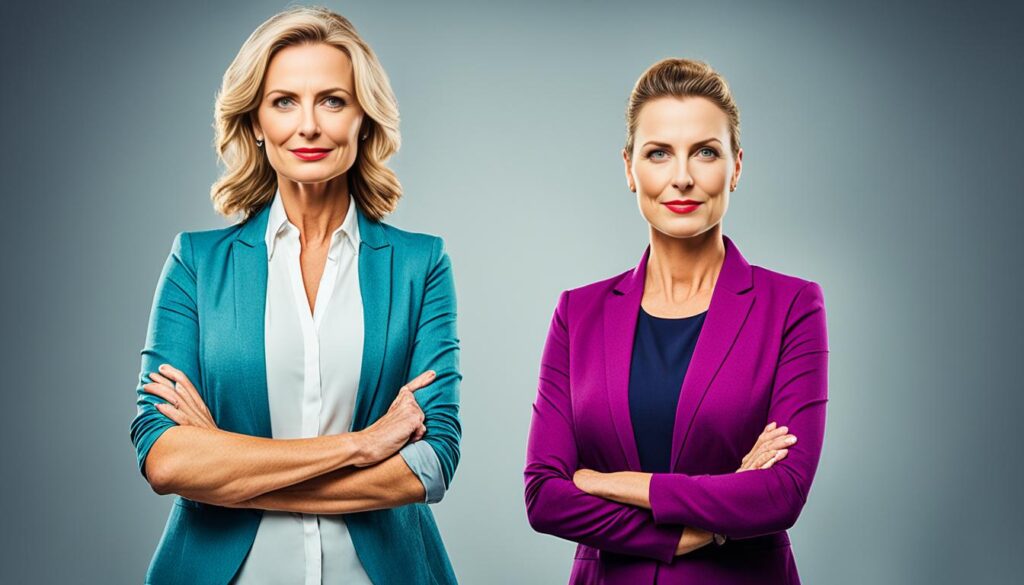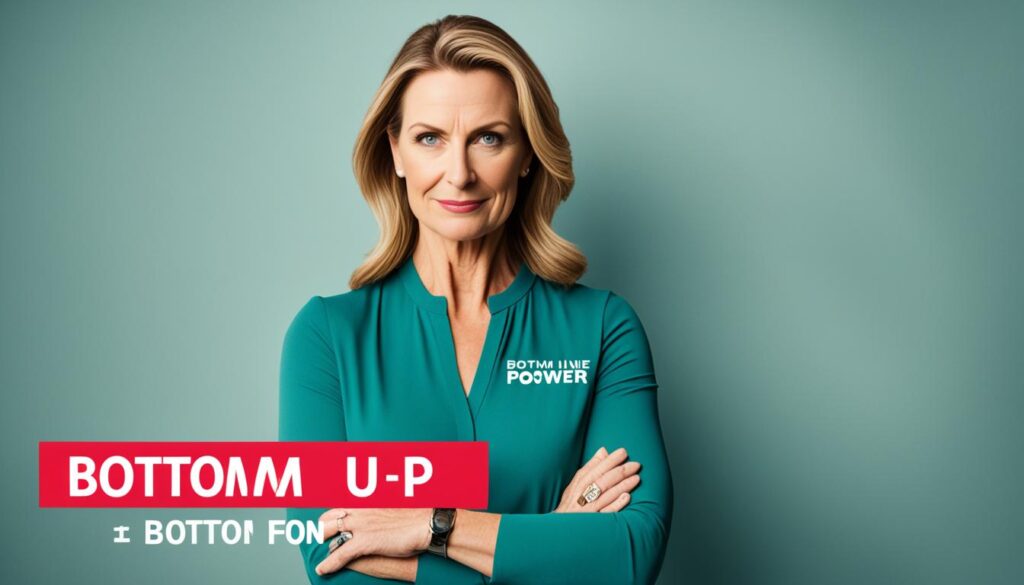As a professional woman, effective communication can unlock your potential. But sometimes, traits that make you a great collaborator can undermine commanding attention.
Sarah, a rising star, struggled to be heard in meetings. Despite her brilliance, she hesitated, apologized excessively, and her voice trailed off.
Sarah’s natural consensus-building mindset inadvertently undermined her authority. After attending a workshop, she transformed her style by projecting confidence, clarity, and assertiveness.
This guide provides strategies, tips, and effective communication approaches for female professionals to advance their careers and amplify their voices.
Key Takeaways
- Leverage warmth and empathy to build trust and influence
- Use purposeful body language and gestures to project confidence
- Eliminate filler words, speak with clarity and conviction
- Be direct and concise in your communication
- Separate your reactions from your professional responses
Speak with Purpose and Vocal Conviction
As a professional woman, your voice is powerful. Focus on pitch, projection, and pace to boost authority. Lowering your pitch can assert leadership in business.
Projecting your voice with purpose and intentional pauses overcomes stereotypes. Avoiding upspeak and vocal fry conveys confidence. Using purposeful gestures enhances your presence.
Pitch, Projection and Pace
Projecting with authority is crucial for being heard. Activate your core and avoid upspeak. End sentences at the same or lower tone.
Projecting Authority with Your Voice
Speaking with conviction develops through practice. Good speakers exhibit knowledge, enthusiasm, and clear diction. Honing this skill allows respect in meetings.
Avoiding Upspeak and Vocal Fry
Upspeak undermines perceived authority in women. Vocal fry, a low, creaky voice, has the same effect. Projecting intentionally avoids these speech patterns.
Steering clear ensures your ideas are taken seriously. You won’t get steamrolled in important discussions.
Eliminate Filler Words
Filler words like “um,” “uh,” “you know,” and “like” can diminish a woman’s credibility and professionalism.3 The first step is identifying your filler words by recording and listening to yourself speak.3
Identifying Your Filler Words
Review recordings of conversations or presentations. Pay attention to overused words and phrases.4 Once identified, work on consciously eliminating filler words from speech.4
Practicing Purposeful Pauses
Pause intentionally for 2-3 seconds. This helps eliminate filler words.3 Longer pauses add emphasis and improve speech flow.3
Embrace purposeful pauses to avoid verbal habits.4 This eliminates filler words, improves flow, and allows emphasis.4
Reducing verbal clutter and pacing speech with pauses enhances credibility.4
| Filler Words to Avoid | Effective Alternatives |
|---|---|
| “Um,” “Uh,” “You know,” “Like” | Intentional pauses, transitional phrases, speaking with purpose |
| “So,” “Basically,” Excessive adjectives/adverbs | Concise, direct language, eliminating unnecessary words |
By practicing purposeful pauses, you improve speech flow for professionalism.34
Own Your Space
Women tend to want to appear smaller and occupy less space.1 Using purposeful gestures that take up space can add authority. Extending elbows and maintaining an open, forward-leaning posture helps women command attention.
Using Purposeful Gestures
Larger, expansive gestures help women project confidence in professional settings. Extending elbows outward and making deliberate, open-armed movements allow women to occupy more space.1 This nonverbal strategy asserts authority and influence.
Commanding Presence
Projecting a commanding presence involves more than just big gestures. Women should move their weight forward and keep arms on the table when seated.1 Wendy Clarke, Sheryl Sandberg, and Glennon Doyle Melton exemplify using body language to command attention.

Be Direct
Women should focus on being declarative and direct.
Get straight to the main point without overanalyzing.
The Skimm writers communicate concisely and impactfully.
1Getting to the Main Point
An effective strategy is being brief, bright, and gone.
Get to the point quickly with clarity and impact.
Avoid over-explaining or justifying for powerful communication.
1Brief, Bright, and Gone
Be direct in communication using concise messaging.
Cut out clutter to achieve concise, impactful messaging.
Avoid verbosity for effective, efficient idea delivery.
1
Bottom Line Up Front
Stating the key point upfront is crucial. This “main idea” should be clearly communicated at the start, allowing audiences to grasp the takeaway.
A 1986 study showed teaching students to identify the main point early led to significant comprehension gains. A 2011 study revealed readers given spoilers in intros could concentrate on details and remember more.
Nielsen research suggests users only read 28% of words on a page per visit, highlighting upfront communication’s importance.
| Name | Upfront Communication Style |
|---|---|
| Elizabeth Gilbert | Clearly states the main idea and key takeaway at the start of her talks and writings, engaging the audience immediately. |
| Meryl Streep | Known for her ability to capture the essence of a character and communicate the core message of a story from the outset. |
| Misty Copeland | Begins her speeches and interviews by articulating the central theme or purpose, setting the stage for the rest of her remarks. |
Writing skills like BLUF contribute to credibility in content marketing and SEO, citing credible sources, keeping information current, and quoting experts.
 5
5Lead with Warmth
Women have an opportunity to leverage warmth and trust to connect. Leading with warmth and a genuine smile can facilitate trust and absorption of ideas.6 According to social psychologist Amy Cuddy, “Warmth is the conduit of influence.”6 Women can use this warmth brand of leadership, differing from traditional male approaches.
Turning Up the Edges of Your Mouth
Prioritizing warmth in communication through nonverbal signals like nods, smiles, or open gestures shows attentiveness and builds trust.6 Incorporating personal storytelling at important conversations’ start can help convey motivation and connect emotionally.6 While warmth strategies may not immediately eliminate double standards, they emphasize kindness alongside competent leadership.
Warmth as a Conduit of Influence
Researchers find warmth and competence are the two primary dimensions forming impressions.6 High warmth but low competence may elicit pity and sympathy. Low warmth and competence can trigger contempt and disgust.6 Low warmth but high competence can trigger jealousy and envy. High warmth and competence are viewed with pride and admiration.6
Beginning with warmth is crucial for leaders, as it facilitates trust, idea absorption, and connection with others.6

Open Conversations for Discovery
Including diverse viewpoints is a strength women can leverage. Economists found women are more collaborative than men.1 This allows gathering insights through open conversations.
Increased collaborative communication and gathering input can lead to greater connection, trust, and sharing empathy. These are valuable tools for effective communication.
Gathering Information and Perspectives
Women can tap into their natural tendencies for perspective-taking and using empathy in communication. Research shows empathy, imagining oneself in someone else’s position, comes more naturally to women.1
Leveraging this skill during conversations can help women build stronger connections. It also helps understand diverse viewpoints, leading to more effective communication and problem-solving.
Leveraging Empathy
When women leverage empathy and build rapport through open discussions, they create an environment conducive to collaboration and idea-sharing.
This approach allows women to uncover hidden insights. It also expands their understanding, enhancing the quality and impact of their communication.

Be Unapologetic
As a professional woman, it’s crucial to avoid over-apologizing.1 Instead of relying on “I’m sorry,” communicate directly without unnecessary qualifiers.1 This approach allows you to convey confidence and authority.
Saying What You Mean
Being unapologetic doesn’t mean being rude or disregarding others.1 It’s about clear, concise, and confident communication.1 Eliminating apologetic language conveys your thoughts with impact.
This helps you be heard and respected.1 It paves the way for more influential interactions.
Separate Reaction from Response
Women are sometimes viewed as “too emotional” when they don’t separate their reaction from their response.7 Females are often perceived to communicate indirectly, elaborately, and emotionally, while males are seen as direct, succinct, and instrumental.7 By avoiding defensive or blame-shifting language and focusing on concrete details and action steps, women can communicate more effectively and influence outcomes.
Sticking to Concrete Details
When responding to challenging situations, women should avoid getting defensive.7 Research shows males are often viewed as more assertive and self-reliant in professional settings, potentially impacting their perceived leadership suitability.7 By focusing on facts and avoiding blame, women can maintain a professional presence and have a greater impact.
Avoiding Defensiveness
Women should be careful not to let emotions overtake them when responding to difficult scenarios.7 Traits associated with males are generally considered more important for educational and professional success, potentially leading to gender stereotypes.7 Examples of women who didn’t handle this well include Hope Solo and Paula Deen, who allowed reactions to overshadow responses.
By staying composed and centered on facts, women can communicate with greater impact and authority.

Effective Communication Strategies for Women
As you navigate the professional world, developing effective communication skills and a solid presence can advance your career.
Communicating with purpose, authority, and impact is crucial. By mastering techniques like voice projection, eliminating filler words, commanding physical presence, and leading with warmth, you can project confidence.
Adopt a direct communication style. Lead with the main point. Separate your emotional reaction from your response. This ensures your message is received with the intended impact.
Embrace collaborative, empathy-driven communication. Research shows women tend to be more inclusive and seek different perspectives in group settings.
Ultimately, prioritizing communication can increase your influence as a female professional. By honing these strategies, you can enhance your visibility, command attention, and position yourself for greater success.
189
Conclusion
This comprehensive guide unveiled effective communication strategies. These are critical for women enhancing professional presence and influence.
By mastering vocal authority, minimizing fillers, commanding physical presence, leveraging warmth and empathy, you’ll communicate purposefully and impactfully.
Communication encompasses more than content – delivery matters. Focus on nonverbal cues, emotional nuances, contextual factors shaping your message. Become a confident, influential communicator.
Implement these strategies, view communication as core competency. Refine vocal delivery, eliminate verbal clutter, own physical space. Lead with balanced warmth and authority.
Mastering these skills propels greater influence, respect, career achievements.11011
FAQ
What are the key areas of a woman’s voice that can boost her authority?
How can women project their voice with authority?
What are some strategies for eliminating filler words?
How can women use body language to project a commanding presence?
What is the “brief, bright, and gone” communication strategy for women?
How can women leverage warmth and trust to connect with individuals?
What is the importance of gathering information and perspectives for effective communication?
How can women avoid undermining their message through over-apologizing?
How can women separate their reaction from their response when communicating?
How Can Effective Communication Strategies Benefit Women Speakers in Changing the Game?
In today’s landscape, the rise of powerful women speakers has sparked the need for effective communication strategies. By harnessing the power of compelling storytelling, confident body language, and genuine connection with the audience, women can elevate their presence and influence, ultimately changing the game in their favor.
Source Links
- https://business360.fortefoundation.org/10-communication-tips-for-women/
- https://www.betterup.com/blog/effective-strategies-to-improve-your-communication-skills
- https://maricarmenpizarro.com/filler-words-an-unlikely-tool-for-effective-communication/
- https://voiceplace.com/eliminate-filler-words-speech/
- https://hawksem.com/blog/bluf-meaning/
- https://www.bossedup.org/podcast/episode322
- https://www.linkedin.com/pulse/influence-gender-communication-style-debbie-churgai
- https://www.girlschase.com/content/how-communicate-and-connect-women
- https://www.pageexecutive.com/advice/region/united-kingdom/how-effectively-communicate-and-influence-female-leader
- https://www.helpguide.org/articles/relationships-communication/effective-communication.htm
- https://www.ncbi.nlm.nih.gov/pmc/articles/PMC2793758/










